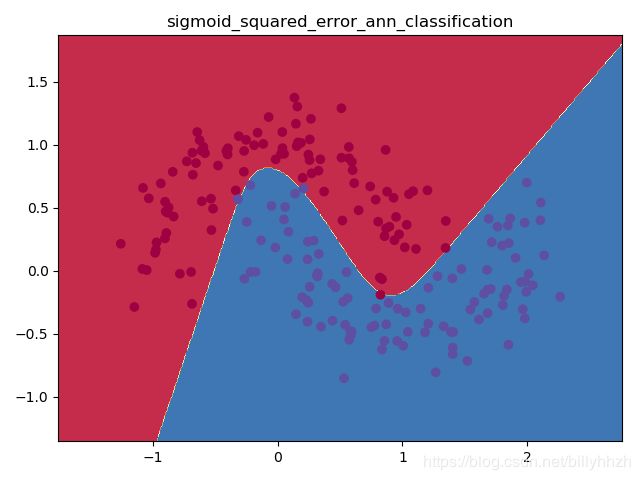Python3神经网络,经典简单示例sigmoid激活函数
选用了sigmoid作为激活函数,作为输出层的计算(多分类版本的logistic回归),影响输出层的delta计算;
选用了squared-error作为损失函数(注:会影响calculate_loss函数的计算以及输出层的delta计算)
__author__ = 'http://clayandgithub.github.io/'
import numpy as np
from sklearn import datasets, linear_model
import matplotlib.pyplot as plt
class NNModel:
Ws = [] # params W of the whole network
bs = [] # params b of the whole network
layers = [] # number of nodes in each layer
epsilon = 0.01 # default learning rate for gradient descent
reg_lambda = 0.01 # default regularization strength
def __init__(self, layers, epsilon = 0.01, reg_lambda = 0.01):
self.layers = layers
self.epsilon = epsilon
self.reg_lambda = reg_lambda
self.init_params()
# Initialize the parameters (W and b) to random values. We need to learn these.
def init_params(self):
np.random.seed(0)
layers = self.layers
hidden_layer_num = len(layers) - 1
Ws = [1] * hidden_layer_num
bs = [1] * hidden_layer_num
for i in range(0, hidden_layer_num):
Ws[i] = np.random.randn(layers[i], layers[i + 1]) / np.sqrt(layers[i])
bs[i] = np.zeros((1, layers[i + 1]))
self.Ws = Ws
self.bs = bs
# This function learns parameters for the neural network from training dataset
# - num_passes: Number of passes through the training data for gradient descent
# - print_loss: If True, print the loss every 1000 iterations
def train(self, X, y, num_passes=20000, print_loss=False):
num_examples = len(X)
expected_output = self.transform_output_dimension(y)
# Gradient descent. For each batch...
for i in range(0, num_passes):
# Forward propagation
a_output = self.forward(X)
# Backpropagation
dWs, dbs = self.backward(X, expected_output, a_output)
# Update parameters of the model
self.update_model_params(dWs, dbs, num_examples)
# Optionally print the loss.
# This is expensive because it uses the whole dataset, so we don't want to do it too often.
if print_loss and i % 1000 == 0:
print("Loss after iteration %i: %f" % (i, self.calculate_loss(X, expected_output)))
# Helper function to evaluate the total loss on the dataset
def calculate_loss(self, X, expected_output):
output_shape = expected_output.shape
num_output = output_shape[0]#training set size
dimension_output = output_shape[1]# output dimension
# Forward propagation to calculate our predictions
a_output = self.forward(X)
current_output = a_output[-1]
# Calculating the loss
data_loss = np.sum(np.square(current_output - expected_output) / 2)
# Add regulatization term to loss (optional)
for W in self.Ws:
data_loss += self.reg_lambda / 2 * np.sum(np.square(W))
return 1. / num_output * data_loss
# Forward propagation
def forward(self, X):
Ws = self.Ws
bs = self.bs
hidden_layer_num = len(Ws)
a_output = [1] * hidden_layer_num
current_input = X
for i in range(0, hidden_layer_num - 1):
w_current = Ws[i]
b_current = bs[i]
z_current = current_input.dot(w_current) + b_current
a_current = sigmoid(z_current)
a_output[i] = a_current
current_input = a_current
#output layer(logistic)
z_current = current_input.dot(Ws[hidden_layer_num - 1]) + bs[hidden_layer_num - 1]
a_current = sigmoid(z_current)
a_output[hidden_layer_num - 1] = a_current
return a_output
# Predict the result of classification of input x
def predict(self, x):
a_output = self.forward(x)
return np.argmax(a_output[-1], axis=1)
# Backpropagation
def backward(self, X, expected_output, a_output):
Ws = self.Ws
bs = self.bs
hidden_layer_num = len(Ws)
num_examples = len(X)
ds = [1] * hidden_layer_num
# output layer
a_current = a_output[-1]
d_current = -(expected_output - a_current) * a_current * (1 - a_current)
ds[hidden_layer_num - 1] = d_current
#other hidden layer
for l in range(hidden_layer_num - 2, -1, -1):
w_current = Ws[l + 1]
a_current = a_output[l]
d_current = np.dot(d_current, w_current.T) * a_current * (1 - a_current)
ds[l] = d_current
#calc dW && db
dWs = [1] * hidden_layer_num
dbs = [1] * hidden_layer_num
a_last = X
num_output = len(X)
for l in range(0, hidden_layer_num):
d_current = ds[l]
dWs[l] = np.dot(a_last.T, d_current)
dbs[l] = np.sum(d_current, axis=0, keepdims=True)
a_last = a_output[l]
return dWs, dbs
# Update the params (Ws and bs) of the netword during Backpropagation
def update_model_params(self, dWs, dbs, num_examples):
Ws = self.Ws
bs = self.bs
hidden_layer_num = len(Ws)
for l in range(0, hidden_layer_num):
Ws[l] = Ws[l] - self.epsilon * (dWs[l] + self.reg_lambda * Ws[l])
bs[l] = bs[l] - self.epsilon * (dbs[l])
#Ws[l] = Ws[l] - self.epsilon * (dWs[l] / num_examples + model.reg_lambda * Ws[l])
#bs[l] = bs[l] - self.epsilon * (dbs[l] / num_examples)
self.Ws = Ws
self.bs = bs
# tranform the label matrix to output matrix (i.e. [0, 1, 1]->[[1, 0], [0, 1], [0, 1]])
def transform_output_dimension(self, y):
class_num = np.max(y) + 1 # start with 0
examples_num = len(y)
output = np.zeros((examples_num, class_num))
output[range(examples_num), y] += 1
return output
def sigmoid(x):
return 1 / (1 + np.exp(-x))
def generate_data(random_seed, n_samples):
np.random.seed(random_seed)
X, y = datasets.make_moons(n_samples, noise=0.20)
return X, y
def visualize(X, y, model):
plt.title("sigmoid_squared_error_ann_classification")
plot_decision_boundary(lambda x:model.predict(x), X, y)
def plot_decision_boundary(pred_func, X, y):
# Set min and max values and give it some padding
x_min, x_max = X[:, 0].min() - .5, X[:, 0].max() + .5
y_min, y_max = X[:, 1].min() - .5, X[:, 1].max() + .5
h = 0.01
# Generate a grid of points with distance h between them
xx, yy = np.meshgrid(np.arange(x_min, x_max, h), np.arange(y_min, y_max, h))
# Predict the function value for the whole gid
Z = pred_func(np.c_[xx.ravel(), yy.ravel()])
Z = Z.reshape(xx.shape)
# Plot the contour and training examples
plt.contourf(xx, yy, Z, cmap=plt.cm.Spectral)
plt.scatter(X[:, 0], X[:, 1], c=y, cmap=plt.cm.Spectral)
plt.show()
class Config:
# Gradient descent parameters
epsilon = 0.01 # learning rate for gradient descent
reg_lambda = 0.01 # regularization strength
layers = [2, 4, 2] # number of nodes in each layer
def main():
X, y = generate_data(6, 200)
model = NNModel(Config.layers, Config.epsilon, Config.reg_lambda)
model.train(X, y, print_loss=True)
visualize(X, y, model)
if __name__ == "__main__":
main()
结果:
Loss after iteration 0: 0.251743
Loss after iteration 1000: 0.085999
Loss after iteration 2000: 0.043758
Loss after iteration 3000: 0.031237
Loss after iteration 4000: 0.028426
Loss after iteration 5000: 0.027443
Loss after iteration 6000: 0.027016
Loss after iteration 7000: 0.026799
Loss after iteration 8000: 0.026676
Loss after iteration 9000: 0.026602
Loss after iteration 10000: 0.026555
Loss after iteration 11000: 0.026525
Loss after iteration 12000: 0.026505
Loss after iteration 13000: 0.026491
Loss after iteration 14000: 0.026481
Loss after iteration 15000: 0.026474
Loss after iteration 16000: 0.026468
Loss after iteration 17000: 0.026464
Loss after iteration 18000: 0.026461
Loss after iteration 19000: 0.026458
